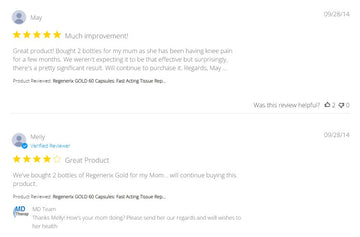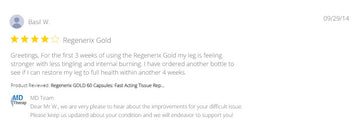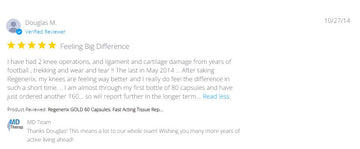Pendulum (Codman) Exercises: Gravity-Assisted Shoulder Motion for Sore, Stiff Shoulders
by MD therapeutics on Aug 17, 2025
Why pendulum exercises help (the principles)
-
Gravity does the work (not your muscles): With the arm relaxed and hanging, the humeral head gently glides in the socket while the rotator cuff stays quiet—great for irritable tendons, bursitis, adhesive capsulitis, or early post-op phases (only as cleared by your clinician).
-
Synovial “wash” & capsular glide: Small, rhythmic arcs circulate synovial fluid and coax a stiff capsule to move without compressive pinch.
-
Pain modulation via gentle motion: Low-threat swinging reduces guarding in upper traps/pecs, often allowing a larger pain-free arc over time.
-
Scalable: You control the arc size, speed, and direction—forward/back, side/side, and small circles.
How to do it (precise, range-aware)
-
Set up: Stand, hinge at the hips, support your non-working hand on a bench or counter. Let the sore-side arm dangle completely relaxed. Soften your knees; keep your neck long.
-
Movements (all pain ≤3/10):
-
Forward/Back gentle swings,
-
Side/Side gentle swings,
-
Small Circles clockwise and counterclockwise.
-
-
Dosage: 20–30 seconds each pattern (or ~10–15 passes), 1–3 sessions/day. Start tiny; increase only if symptoms settle within 24 h.
-
Pro tips: The body creates the motion—don’t shrug or actively lift the arm. If your clinician advises later-stage loading, you may hold a very light weight (0.5–1 kg / 1–2 lb) to smooth the swing—only if comfortable.
-
Modify/avoid: Recent fracture/dislocation, red-hot inflammation, or post-surgical restrictions not yet cleared—follow your surgeon/therapist’s protocol.
Limits of exercise alone
-
Systemic drivers (sleep, stress, diet, metabolic health) still influence pain and recovery.
-
Flares cap training load—people under-dose or stop without recovery support.
-
Capacity gaps: Pendulums calm symptoms but don’t rebuild strength or scapular control; most plans need progressive rotator-cuff/serratus/lower-trap work.
-
Tissue remodeling is slow: Tendons and capsules change over months, not days—consistency plus recovery and nutrition beats “exercise only.”
Why add nutritional correction
-
Improve circulation: Support microvascular flow so the cuff, bursa, and capsule receive oxygen/nutrients after sessions.
-
Promote repair: Provide structural inputs (e.g., collagen peptides, hyaluronic acid) that gentle motion “signals” into tissue remodeling.
-
Reduce excessive inflammation: Keep day-to-day training tolerable and consistent.
-
Avoid tissue damage: Antioxidant and matrix-support nutrients buffer oxidative/catabolic stress from repetitive loading.
Botanicals & nutrients often paired with shoulder-friendly rehab
(Blends traditional lore with published research; evidence ranges from promising to mixed. Check interactions and personal suitability with your clinician.)
-
Ginger (Zingiber officinale): Long used in Ayurveda/East Asian medicine for circulation and “wind-damp” aches; standardized extracts show modest symptom support for some with osteoarthritis.
-
Turmeric / Curcumin (Curcuma longa): Core Ayurvedic spice; bioavailability-enhanced curcumin has reduced arthritis pain and improved function in multiple studies; culinary turmeric alone is low in curcumin.
-
Boswellia / Frankincense (Boswellia serrata): Ayurveda’s shallaki; standardized extracts associated with improved pain/function in osteoarthritis cohorts.
-
Winter Cherry / Ashwagandha (Withania somnifera): Adaptogen for resilience; trials suggest immunomodulatory effects and symptom support that may aid training tolerance.
-
Collagen Peptides (Type II focus): Provide peptides that may support cartilage and connective-tissue metabolism—useful alongside gentle joint motion.
-
Hyaluronic Acid (oral): Contributes to lubrication/viscosity; often used to support smooth, comfortable shoulder motion.
-
Cat’s Claw (Uncaria spp.): Amazonian tradition for “rheumatism”; small trials show short-term pain improvements, though the overall evidence base remains limited.
The practicality problem
-
Food-only dosing is tough: Hitting research-like intakes of curcumin or ginger via meals every day is impractical.
-
Pill burden & cost add up: Buying six–seven separate products (ginger, turmeric, boswellia, ashwagandha, collagen, HA, cat’s claw) means many capsules and a higher monthly spend—versus one comprehensive formula.
A convenient all-in-one option: Regenerix Gold™
Prefer pendulums + nutrition without juggling bottles?
-
What’s inside: Hydrolyzed Type II Collagen, Hyaluronic Acid, and a proprietary blend of Ginger, Turmeric, Frankincense (Boswellia), Cat’s Claw, and Winter Cherry (Ashwagandha)—the same seven ingredients discussed above—combined to promote healthy joint and muscle function and support everyday recovery.
-
Need only: 2–3 capsules daily.
-
Price: $98 a bottle.
-
Why it fits here: One product covering seven evidence-linked ingredients is simpler—and typically more cost-effective—than buying 5–7 separate supplements.
-
Track record: Recommended by doctors and physical therapists internationally for about a decade (individual clinician views vary).
Supplements support healthy function; they don’t diagnose, treat, or cure disease. Check interactions (e.g., anticoagulants with turmeric/ginger/boswellia) and suitability with your clinician.
This week’s shoulder mini-plan
-
Daily: Pendulums—forward/back, side/side, circles (both ways), 20–30 s each, pain ≤3/10.
-
3×/wk add-ons (as symptoms allow):
-
Scapular clocks (light band),
-
Isometric external rotation at side,
-
Wall slides with gentle upward rotation.
-
-
If symptoms spike: Shrink the arc by 50% or switch to short bouts (10–15 s). If pain radiates past the elbow or night pain worsens, check in with your clinician.



